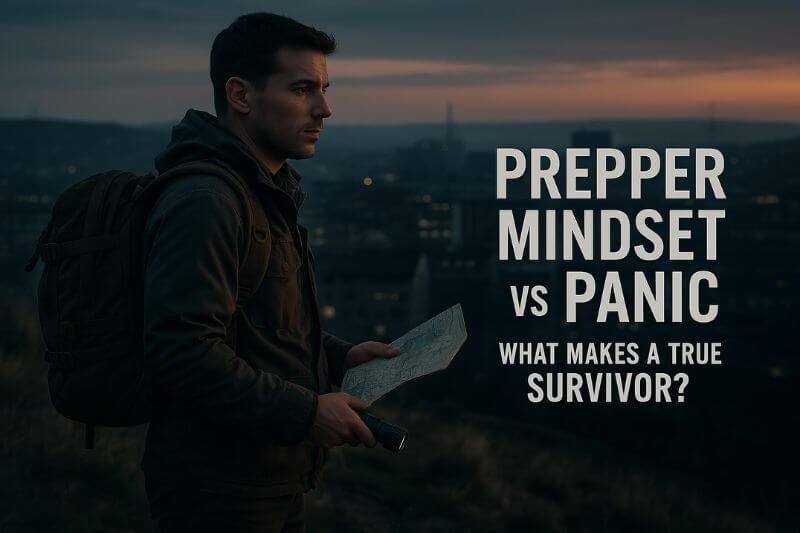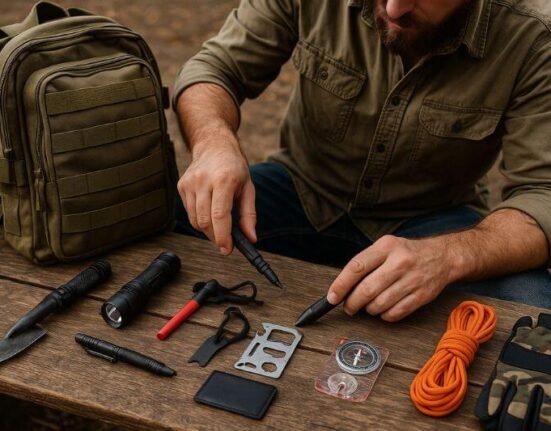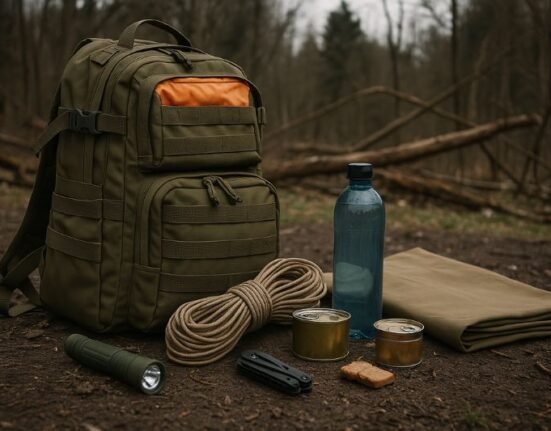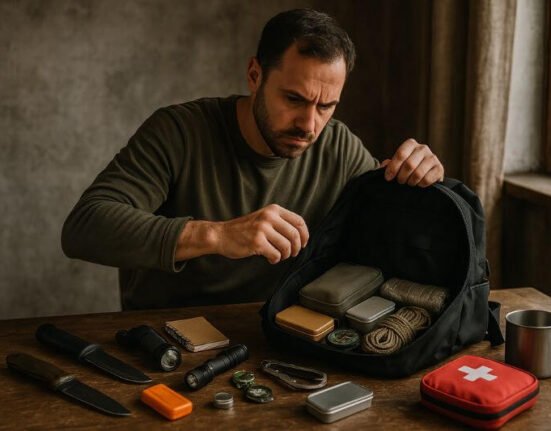The biggest threat in any crisis is not outside — it’s inside. The prepper mindset is what keeps you focused when others are paralyzed by fear. And the difference between calm and chaos? It starts in the way you think.
You can own the best gear, have bug-out plans and supplies, but if panic takes over… none of it matters.
The true survivor isn’t the strongest. It’s the one who stays mentally composed under pressure.
Why panic spreads faster than danger
Disasters don’t always kill. Panic does.
History is filled with examples where people died not from the crisis itself, but from the irrational reactions it triggered.
In 2003, a stampede in a crowded Chicago club killed 21 people — not from the initial threat, but from people panicking in tight spaces.
In 2020, supermarket shelves emptied in hours over the fear of lockdowns — not because of real shortages, but because people copied fear.
Panic is contagious. It hijacks logic. It blinds the group.
The prepper mindset exists to stop that cascade before it starts.
What is the prepper mindset, really?
It’s more than being “prepared.” It’s a way of thinking, seeing, and acting long before crisis hits.
The prepper mindset is:
- Acceptance of uncertainty
- Willingness to act early
- Detachment from herd behavior
- Calm under sudden stress
- Adaptation over emotion
It’s not about living in fear. It’s about living with clarity — before, during, and after collapse.
“Preparedness is not panic. It’s proactive control in a chaotic world.”
— CivilFall Psychological Readiness Guide
The science behind panic and decision breakdown
Panic isn’t weakness — it’s biological.
When faced with threat, the amygdala (emotional brain) floods the system with fear hormones. Heart races. Tunnel vision kicks in. Rational thinking shuts down.
This is useful when outrunning a bear. But in survival — it’s a liability.
The prepper mindset trains the prefrontal cortex — the decision-making part of the brain — to stay active, even under threat.
Here’s how they compare:
| Mental State | Dominant Brain Zone | Effect on Survival |
|---|---|---|
| Panic | Amygdala (emotional) | Impulsive, disorganized |
| Prepper Mindset | Prefrontal cortex (logic) | Calm, deliberate decisions |
How the prepper mindset rewires your instinct
The biggest myth? That mindset is fixed. It’s not.
The prepper mindset is trained through pattern recognition and repetition.
By rehearsing emergencies, imagining outcomes, simulating loss — you build neural resilience.
You create a new baseline of calm.
That means when collapse comes, your first instinct isn’t fear — it’s action.
Traits of a panic-prone person vs a trained prepper
Panic-prone individuals often:
- Need social confirmation before acting
- Get overwhelmed by too many options
- Focus on worst-case fears, not solutions
- Follow others even when wrong
- Struggle to lead under stress
Preppers with a strong mindset tend to:
- Act without waiting for “permission”
- Limit inputs and simplify decisions
- Accept what they can’t control
- Influence others through calm
- Move early, not late
Spotting your own weaknesses
Nobody’s perfect. But awareness is power.
Ask yourself:
- Do I delay decisions under pressure?
- Do I follow emotional cues from others?
- Do I catastrophize situations?
- Can I function without approval or guidance?
If you answered “yes” to two or more, don’t worry — that’s your training roadmap.
Building the Prepper Mindset: Tools, Habits, and Real Drills
Mindset isn’t built during the crisis. It’s built before.
Panic is a habit of inaction. The prepper mindset is a habit of preparation — mental, not just material.
Here’s how to train your brain to stay calm, logical, and responsive in any emergency.
Start with daily mindset conditioning
Mental strength doesn’t require hours per day. It starts with 3–5 minute routines designed to:
- Anchor your focus
- Normalize discomfort
- Reframe fear into action
Try these every morning:
- Cold exposure (shower or outside air) — builds control under stress
- Visualization: imagine a specific threat, walk yourself through how you’d handle it
- Short breath control drill (inhale 4, hold 4, exhale 4, hold 4) — reduces overreaction
These rituals reprogram your brain to respond rather than react.
“Discipline isn’t about perfection. It’s about direction.”
— CivilFall Resilience Protocol, 2025
Run “first 60 seconds” response scenarios
In any disaster, your first minute matters most. Panic steals it. Training protects it.
Create a weekly schedule of simulated scenarios where you have to respond instantly:
- Gas leak
- Flash flood warning
- Civil unrest outside your home
- EMP strike during dinner
- Phone alert of incoming missile
Start a timer. Speak or write your response. What do you do in 60 seconds? Who do you protect? What tool do you grab?
The more reps, the faster your brain associates pressure with performance — not paralysis.
Learn to disconnect from crowd behavior
One of the core traits of the prepper mindset is independence of thought.
In crowds, panic spreads through:
- Eye contact
- Voice escalation
- Sudden movements
- Verbal speculation
Train yourself to pause when others react. Look around. Breathe. Ask: “What do I actually know right now?”
Practice micro-isolation: being in a group without copying the group.
Try this drill:
- Go to a busy place (station, mall, park)
- Sit still, silent, no phone
- Observe for 10 minutes without reacting to movement or sound
- Mentally note how many people are copying each other unconsciously
This builds your ability to stay centered — even when surrounded by emotion.
Build mental momentum through micro-wins
The prepper mindset needs daily fuel.
Each small decision that requires discipline (no sugar, 6 a.m. wake-up, cold shower, hike in rain) trains your nervous system to override short-term discomfort.
Log these moments daily. They are proof of your personal agency.
The more often you choose control over comfort, the more resilient your default setting becomes.
Stress inoculation: progressive pressure drills
Borrowed from military psychology, stress inoculation means exposing yourself to controlled discomfort to build future tolerance.
Here’s a sample monthly prepper mindset ladder:
| Week | Drill | Target Outcome |
|---|---|---|
| Week 1 | Sleep on hard surface for 1 night | Remove comfort dependence |
| Week 2 | Skip 2 meals in 24h window | Normalize low-energy clarity |
| Week 3 | Navigate without tech (map only) | Improve decision speed in unknowns |
| Week 4 | Train in bad weather (walk/run) | Remove reliance on ideal conditions |
You don’t need to suffer. You just need to adapt.
Emotional control training
The prepper mindset is not “tough guy” bravado. It’s emotional fluency.
You feel the fear — but it doesn’t steer you.
Each day, take 2–5 minutes to reflect on an emotion you felt strongly.
Ask:
- What triggered it?
- What did it make me want to do?
- Did I follow that impulse?
- What else could I have done?
This rewires your default response from reactive to reflective — a crucial upgrade in real collapse.
Internal leadership drills
In a survival situation, you may have to lead — whether you want to or not.
Try role-reversal scenarios with family or prepping partners:
- You’re the calm leader. They simulate panic.
- You give instructions, one at a time, clearly and slowly.
- Practice giving hard truths gently but firmly.
- End each scenario by debriefing what worked and what didn’t.
Leadership isn’t about dominance. It’s about emotional stability under chaos — a prepper’s most transferable asset.
Field Application of the Prepper Mindset: Staying in Control When Others Lose It
Training is essential — but true mindset is proven in the field.
In real-world collapse, the prepper mindset isn’t theoretical. It’s your last defense against psychological breakdown.
When systems fail, mindset takes over
In the early hours of Hurricane Harvey, Houston saw thousands stranded by rising water.
Some waited too long to evacuate. Others drove into water despite warnings. Many simply froze.
The survivors? Often not the strongest or most equipped — but the most mentally adaptive.
They moved early. They took initiative. They helped others while protecting their own.
They weren’t fearless — they were mentally conditioned to act through the fear.
“Your gear might fail. Your friends might disappear. Your mindset is the one thing you control.”
— CivilFall Survival Psychology Handbook
The cost of poor mental preparation
Mindset errors kill in subtle ways:
- Denial: “It won’t get that bad.”
- Delay: “Let’s wait for more news.”
- Herd instinct: “Everyone’s staying, so we will too.”
- Dependency: “The government will handle it.”
These are not flaws of intelligence — they’re flaws of mental discipline.
And every one of them is fixable through prepper mindset training.
Mistake recovery protocol
You won’t get it right 100% of the time. That’s reality.
But a trained mind has a system to recover:
- Pause and breathe.
- Acknowledge the error without blame.
- Ask: “What can still be done right now?”
- Reset the plan.
- Act decisively on the next best option.
This shift from shame → action is what prevents spirals in crisis.
Case study: grid down panic vs prepared action
Imagine this scenario:
It’s 8:47 PM. Power goes out. No cell signal. Outside, you hear sirens and shouting. Your neighbors are panicking. Some get in cars. Others scream for help.
A panic-based reaction:
- Check 10 sources for info, none load.
- Ask spouse what to do — they panic too.
- Go outside barefoot with a flashlight.
- Follow neighbors leaving blindly.
A prepper mindset reaction:
- Breathe once, check that all family are present.
- Close and lock all doors and windows.
- Go to fallback power and grab comms setup.
- Observe quietly for 10 minutes.
- Begin Plan A: shelter-in-place checklist.
Same event. Different mind. Different outcome.
Teaching the prepper mindset to your group
If you’re the calmest person in the room, you’re the leader.
And that means it’s your responsibility to help stabilize others.
How to do it in the field:
- Speak slowly, use people’s names
- Assign small, specific tasks
- Never say “calm down” — model calmness instead
- Offer one positive anchor: “We’ve trained for this.” or “We’re not alone.”
- Touch base every 30 minutes to realign roles and focus
This turns fear into function.
After the storm: post-crisis mindset maintenance
Surviving is one part. Staying stable afterward is just as critical.
Expect these emotional waves:
- Relief
- Guilt
- Exhaustion
- Irritation
- Grief
You’re not weak — you’re human.
What helps?
- Daily journaling
- Talking with other survivors
- Quiet time in nature
- Structured routine
- Reframing: “We endured. What’s next?”
Mental resilience doesn’t end when the sirens fade. It’s an ongoing practice.
Internal resources to go deeper
- Survival Psychology: Understanding Fear, Focus, and Decision-Making
- Family Bug Out Strategy: How to Prepare With Kids and Elderly
Trusted external link
Final takeaway: Mindset is your ultimate prep
Your food may run out. Your bug-out vehicle might fail.
But your prepper mindset is portable, renewable, and indestructible — if you train it.
Don’t wait for chaos to practice calm. Don’t hope fear won’t show up — train to walk through it.
Be the one who acts while others freeze. The one who thinks clearly when emotion clouds the air.
That’s a true survivor.
Train your mindset. Sharpen it daily.
Because when panic strikes, your thinking is your first line of defense — and your last.















